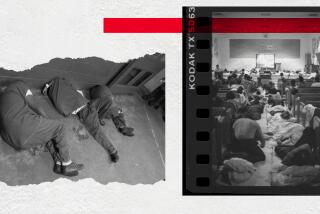Gates Gets Inmates off Jail Floors to Meet Deadline
- Share via
Sheriff Brad Gates was able to comply with a federal court order Sunday that no inmates at the overcrowded Orange County Jail be forced to sleep on the floor for more than 24 hours.
But he was able to make the deadline only with the help of Municipal Court employees who worked overtime to screen arrestees and released three times the number of inmates who are usually freed pending court appearances, Gates’ top aides said Monday.
No Vacancy at Branch Jails
From Friday night through Sunday night, 324 new prisoners were released on their own recognizance instead of being sent to the housing area of the jail. The typical weekend number is between 100 to 120 prisoners, said Don Bell, director of Central Municipal Court’s detention release program.
Meanwhile, the county’s two branch jails, Theo Lacy in Orange and the James A. Musick Honor Farm near El Toro, were filled to capacity over the weekend to help reduce the population at the main jail, said Undersheriff Raul Ramos.
The population at the main jail in Santa Ana on Sunday night was 1,424, the lowest it has been in years, he added.
Gates was also helped by the fact that the number of weekend arrests was not particularly high, Ramos said. He warned, however, that the sheriff’s office has no control over the number of arrestees sent to the jail, or the number of people now released on their own recognizance who might later be sentenced to jail by the courts.
“We’re in compliance with the court order now, but it’s going to be a day-to-day effort,” Ramos said. “If arrests go up next week, who knows what will happen?”
U.S. District Judge William P. Gray on March 18 fined the county $10 a day for each inmate who had to sleep on the floor past the first 24 hours because of overcrowding. On Aug. 15, he strengthened that order to say no inmates could be on the floor past 24 hours but gave Gates until Sunday night to comply.
$10-a-Day Fines
The number of inmates sleeping on the floor due to overcrowding has dwindled from more than 500 at the time of Gray’s March 18 order to less than 50 in recent weeks, and on most days it has been fewer than 20 prisoners, officials said.
But beginning last Friday, there were no inmates on the floor, even within the judge’s allotted 24-hour period, Ramos said.
How did the population get so low just in time to comply with Gray’s order?
“Two things did it,” Ramos said. “Those court people (from detention release) worked their hearts out to help us. And our own people worked hard to see to it that if we had a bed available at our other facilities, we had an inmate there immediately ready to take it over.”
Detention release officials from Central Municipal Court have an office in the booking area on the first floor of the jail and screen every new inmate to see if that inmate is eligible for release on his own recognizance, or for a low bail.
An investigator from detention release is at the jail 24 hours, and on weekend nights it’s often two investigators. This past weekend, however, six investigators were on duty, most working shifts from 12 to 20 hours, detention release director Bell said. Bell, who is a full-time administrator, added that he worked a 20-hour shift himself.
The more investigators available, the more people who can be released on their own, Bell explained.
“It just takes time to check out the inmates’ stories,” he said. “If an inmate says he has a job to go to Monday morning if you let him out, and you don’t have anybody available at 2 o’clock Sunday morning to call his boss to verify (it), then he’s going to have to stay in jail.”
Bell has declined to say whether the judges who control the detention release program approved relaxing its standards, as Gates had requested, to help keep the population down.
But he added: “I can tell you that not a single person was turned loose who would be a threat or a danger to the community.”
More to Read
Sign up for Essential California
The most important California stories and recommendations in your inbox every morning.
You may occasionally receive promotional content from the Los Angeles Times.













